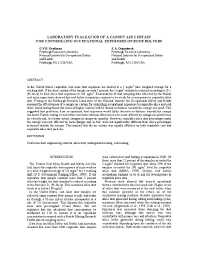Mining Publication: Laboratory Evaluation of a Canopy Air Curtain for Controlling Occupational Exposures of Roof Bolters
Original creation date: June 2001
In the United States, respirable coal mine dust exposures are limited to a 2 mg/m3 time weighted average for a working shift. If the silica content of the sample exceeds 5 percent, the 2 mg/m3 standard is reduced according to 10 ) (% silica) to limit silica dust exposures to 100 µg/m3. Examinations of dust sampling data collected by the federal coal mine inspectorate showed that roof bolter occupations continue to be at risk for overexposure to respirable silica dust. Testing at the Pittsburgh Research Laboratory of the National Institute for Occupational Safety and Health assessed the effectiveness of a canopy air curtain for controlling occupational exposures to respirable silica and coal dusts. Initial testing found that zones of higher velocity airflow shrank as distance beneath the canopy increased. This suggested that protection from occupational dust exposures would likely decrease as distance beneath the canopy increased. Further testing revealed that coal dust reduction efficiencies were most affected by changes in interference air velocity and, to a lesser extent, changes in canopy air quantity. However, respirable silica dust percentages under the canopy were not affected by such changes and, in fact, were not significantly different from silica percentages measured outside the canopy. This implied that the air curtain was equally effective on both respirable coal and respirable silica dust particles.
Authors: GV Goodman, JA Organiscak
Conference Paper - June 2001
NIOSHTIC2 Number: 20021319
Proceedings of the Seventh International Mine Ventilation Congress, June 17-22, 2001, Crakow, Poland. S Wasilewski, ed., Crakow, Poland: Research & Development Center for Electrical Engineering and Automation in Mining (EMAG), 2001 Jun; :299-305
See Also
- Control of Respirable Dust
- Development of a canopy air curtain to reduce roof bolters’ dust exposure
- Development of a Roof Bolter Canopy Air Curtain for Respirable Dust Control
- Emerging Technologies Control Respirable Dust Exposures for Continuous Mining and Roof Bolting Personnel
- Equivalency of a Personal Dust Monitor to the Current United States Coal Mine Respirable Dust Sampler
- Evaluating Portable Infrared Spectrometers for Measuring the Silica Content of Coal Dust
- An Evaluation of Methods for Controlling Silica Dust Exposures on Roof Bolters
- Evaluation of the Approach to Respirable Quartz Exposure Control in U.S. Coal Mines
- Improving Silica Dust Control Through Targeted Research
- Respirable Quartz Hazard Associated with Coal Mine Roof Bolter Dust
- Page last reviewed: 9/21/2012
- Page last updated: 9/21/2012
- Content source: National Institute for Occupational Safety and Health, Mining Program


 ShareCompartir
ShareCompartir
